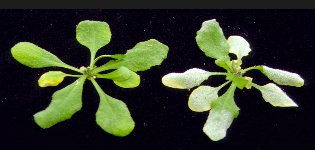
Katrina Ramonell
she/her/hersAssociate Professor
Undergraduate Coordinator
- kramonel@ua.edu
- 1339 Science and Engineering Complex (SEC)
- Not Accepting Students
Education
- Postdoctoral research: Carnegie Institution of Washington
- PhD, Plant Physiology, Louisiana State University, 1999
Research Interests

Our laboratory uses the model plant, Arabidopsis thaliana, to study the complex interactions between plants and pathogens in the environment. Specifically, we are interested in the interaction between Arabidopsis and the obligate fungal pathogen Erysiphe cichoracearum, the causal agent of powdery mildew disease. Arabidopsis is a superior system for this research because of its small size, short generation time (45 days) and availability of large numbers of mutant lines and genomic resources. In addition, the Arabidopsis genome has been fully sequenced and detailed genetic and physical maps are publicly available. These tools greatly enhance our ability to clone and characterize genes of interest. Our lab utilizes genomics technology coupled with genetic and molecular techniques to study the signal transduction pathways involved in plant defense.
There are two major projects ongoing in the lab. One project focuses on the role of the fungal elicitor chitin in plant-pathogen interactions. Plants cannot move away from stresses and pathogens they encounter in their environment. Therefore they have evolved intricate mechanisms to handle the numerous conditions encountered in nature. The recognition of potential pathogens and the induction of appropriate defense responses are vital for survival. Various fungal components are known to act as elicitors of plant defense responses. One of these elicitors is chitin, a polysaccharide composed of ß-1-4-linked N-acetylglucosamine. It is found in fungal cell walls, insect exoskeletons and the hard carapace of crustaceans. Our work is focused on understanding the genes involved in chitin perception and signaling leading to plant defense responses. We are using DNA microarrays to help us identify and characterize genes involved in chitin signaling in order to better understand the interactions between plants and pathogenic fungi.

A second focus in the lab involves the characterization of susceptibility factors in plant-pathogen interactions. In plant-pathogen interactions that follow the classical gene-for-gene interaction, incompatibility (no disease) depends on the interaction of specific resistance (R) genes in the plant with correspondingavirulence (avr) genes in the pathogen. Compatibility (disease) occurs when either the resistance gene is absent or non-functional or the pathogen lacks or has altered the corresponding avirulence gene. Plants are constantly being challenged by potential pathogens in the environment. However, the majority of these interactions do not result in the induction of defense responses in the plant or in the development of disease symptoms. We are particularly interested in genes that play an active role in compatible interactions between Arabidopsis and fungal pathogens. Characterization of these genes might allow us to “turn off” the interaction between fungus and plant in order to stop the disease process before it begins. We are using genomic techniques along with genetics and molecular biology to help us characterize and understand the roles of these genes in plant-pathogen interactions.
Selected Publications
- Yang X, Deng F, and Ramonell KM (2012) Receptor-like kinases and receptor-like proteins: keys to pathogen recognition and defense signaling in plant innate immunity. Front. Biol. 7(2): 155–166.
- Antico CJ, Colon C, Banks T, and Ramonell KM (2012) Insights into the role of jasmonic acid-mediated defenses against necrotrophic and biotrophic fungal pathogens. Front. Biol. 7(1): 48–56.
- Berrocal-Lobo M, Stone S, Yang X, Antico J, Callis J, Ramonell, K and Somerville, S (2010) ATL9, a RING Zinc Finger Protein with E3 Ubiquitin Ligase Activity Implicated in Chitin and NADPH Oxidase-Mediated Defense Responses. PLoS ONE 5(12): e14426. doi:10.1371/journal.pone.0014426
- Wan J, Ramonell K, Zhang X, Clough S, Zhang R, Libault M, Stacey M, Hong JC, and Stacey G (2008) Chitin signaling in Arabidopsis. In M. Lorito, SL Woo, and Scala F (eds.) Biology of Plant Microbe Interactions, Vol. 6. The American Phytopathological Society, St. Paul, MN.
- Wan, J, Zhang, X-C, Neece, D, Ramonell KM, Clough, S, Kim S-Y, Stacey, MG, Stacey, G (2008) A LysM receptor-like kinase plays a critical role in chitin signaling and fungal resistance in Arabidopsis. Plant Cell, 20: 471-481.
- Goff, K and Ramonell, KM (2007) The role and regulation of receptor-like kinases in plant defense. Gene Regl. Syst. Biol., 1: 167-175.
- Trupti, J., Wan, J., Palm, C.J., Juneau, K., Davis, R., Southwick, A., Ramonell, KM, Stacey, G., Xu, D. (2006) Bioinformatics analyses of Arabidopsis thaliana tiling array expression data. In Y. Pan and X. Hu (ed.) Knowledge Discovery in Bioinformatics: Techniques, Methods and Applications, John Wiley and Sons, New York.
- Ramonell, KM, Berrocal-Lobo, M., Wan, J., Stacey, G. and Somerville, S. (2005) Loss-of-function mutations in chitin responsive genes show increased susceptibility to the powdery mildew pathogen, Erysiphe cichoracearum. Plant Physiology, 138: 1027-1036.
- Assaad, F.F., Qiu, J-L., Youngs, H., Erhardt, D., Zimmerli, L., Kalde, M., Wanner, G., Peck, S.C., Ramonell, K., Somerville, C.R., Thordal-Christensen, H. (2004) The PEN1 syntaxin defines a novel compartment upon fungal attack and is required for the timely assembly of papilla. Molecular Cell Biology, 15 (11): 5118-5129.
- Ramonell, K.M., Zhang, B., Ewing, R., Chen, Y., Xu, D., Stacey, G., and Somerville, S. (2002) Microarray analysis of chitin elicitation in Arabidopsis thaliana. Molecular Plant Pathology, 3: 301-311.
- Zhang, B., Ramonell, K., Somerville, S., and Stacey, G. (2002) Characterization of early, chitin-induced gene expression in Arabidopsis. Molecular Plant Microbe Interactions, 15: 963-970.
- Ramonell, K.M., McClure, G.M., and Musgrave, M.E. (2002) Oxygen control of ethylene biosynthesis during seed development in Arabidopsis thaliana (L.) Heynh. Plant, Cell and Environment, 25: 793-801.
- Ramonell, K.M. and Somerville, S. (2002) The genomics parade of defense responses: to infinity and beyond. Current Opinion in Plant Biology, 5: 291-294.
- Wu, S-H, Ramonell, K.M., Gollub, J., Somerville, S. (2001) Plant gene expression profiling with DNA microarrays. Plant Physiology and Biochemistry, 39: 917-926.
- Ramonell, K.M., Kuang, A., Porterfield, D.M., Crispi, M.L., Xiao, Y, McClure, G.M and Musgrave, M.E. (2001) Influence of atmospheric oxygen on leaf structure and starch deposition in Arabidopsis thaliana. Plant, Cell and Environment, 24: 419-428.